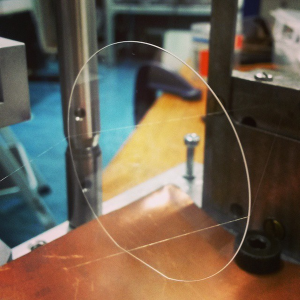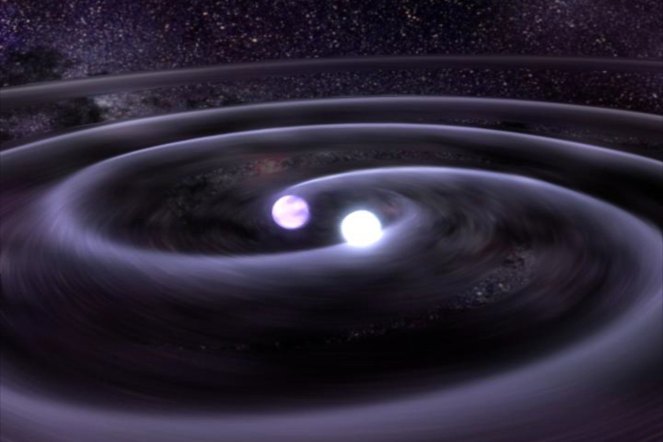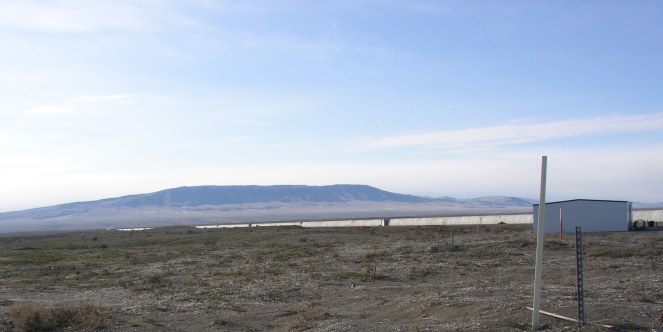Edit 12/03/16: I just wanted to say hello to anyone who was Googling stuff about gravitational waves and found themselves here. People use some really interesting search terms to get here and I want you to know that if you have any questions I will absolutely do my best to answer them. Ok, now you can read the blog post.
My PhD is in materials physics for the next generation of gravitational wave detectors. That’s a fancy way of saying I spend a lot of time in a lab trying to understand the behaviour of pieces of sapphire, silicon and silica. One day this will help to inform the design of a huge machine which will be used to observe wobbles in space. The sapphire and silica both look like glass, the silicon is shiny and dark grey.

Those space wobbles, or gravitational waves, as my boss prefers me to call them, are caused by huge, violent events going on out in the cosmos. Things like colliding black holes and exploding stars. It’s dramatic stuff. Turns out that’s because you need a whole lot of energy to make space wobble even a teeny tiny bit.
When there is enough energy to make waves, the waves are really small. So they’re really hard to detect. Einstein predicted them about 100 years ago and even he thought we’d never be able to find them because they’d be too small. However, scientists are tenacious. Here’s a rough timeline (after the fancy picture):

- 1916: Albert Einstein publishes a Review Article on General Relativity, it is suggested that gravitational waves are a result of general relativity but it’s not clear that they will be directly detectable.
- 1955: Joseph Weber, an American physicist, takes a sabbatical to work with John Archibald Wheeler. He develops an early design for a gravitational wave detector that takes the form of a large aluminium bar. If a gravitational wave passes the bar, it should cause it to ring.
- 1968: Joseph Weber claims to have “good evidence” of a detection but others point out that his equipment should not be able to detect waves so small. The claim remains controversial.
- 1972: A “Weber bar” is sent to the Moon with Apollo 17.
- 1974: Hulse and Taylor discover a binary pulsar. A pulsar is a kind of neutron star which sends out radio waves periodically as it spins. This one was orbiting a different star. Hulse and Taylor observed it for a long time.
- 1983: Hulse and Taylor published a paper saying that the period of the pulses from their pulsar was changing. That the system must be losing energy. From their measurements, the only known way for this energy to be lost was through gravitational waves.
- 1992: Kip Thorn, Ronald Dreever and Rainer Weiss cofound LIGO: The Laser Interferometric Gravitational Wave Observatory. This is a new kind of gravitational wave detector which uses a laser to measure the position of mirrors 4 kilometers away. The measurements are very precise. If a gravitational wave passes the detector the mirrors will move and that movement will be picked up. There are to be three detectors: One in Livingston, Louisiana and two in Hanford in Richland, Washington.
- 1993: Hulse and Taylor receive the Nobel Prize for Physics for the first indirect detection of gravitational waves.
- 1993: The Virgo detector, similar to LIGO is founded in Italy, with collaborators in France, The Netherlands, Poland and Hungary. It gets final approval in 1994.
- 1995: Construction of the GEO600 detector begins. This again is similar to LIGO but has shorter arms. It will become the test bed for many new technologies
- 1995: The TAMA project begins in Japan. Like GEO600, this is another, smaller interferometric detector. Again, it was a test bed used for developing technologies
- 2002: The LIGO detectors are built and the search with this kind of detector begins. It continues until 2010, when they are shut down for upgrades that will make the detectors even more sensitive.
- 2003: TAMA stops taking data but is still used as a testing facility.
- 2003: MiniGRAIL is built. This is a bar-type detector, with one obvious difference: Instead of being a bar, it’s a sphere. It is operated at cryogenic temperatures to improve sensitivity.
- 2003: The construction of the Virgo detector is completed.
- 2005: A different approach is taken with “pulsar timing.” This is more like the original indirect detection made by Hulse and Taylor. The Parkes Pulsar Timing Array begins collecting data.
- 2006: CLIO, the Cryogenic Laser Interferometry is built in the Kamioka mine in Japan, it will pave the way for KAGRA.
- 2007: Virgo starts taking data
- 2008: The Deci-Hertz observatory is proposed. It would be a space based observatory run by Japan.
- 2009: LIGO India, or IndIGO, is proposed.
- 2010: The LCGT (Large Scale Cryogenic Gravitational Wave Telescope) is approved in Japan.
- 2011: Virgo is decommissioned so that upgrades can be made to improve sensitivity. Advanced Virgo is planned to go online in 2016.
- 2011: NASA announces that it will be unable to fund LISA due to funding limitations. ESA now needs to fund it alone which requires scaling down the mission. The scaled down version is originally called NGO (the New Gravitational-wave Observatory) but is later renamed eLISA.
- 2012: LCGT is renamed KAGRA (the Kamioka Gravitational Wave Detector).
- 2014: BICEP2 reports a detection of gravitational waves which is later retracted when it is discovered that a different effect has been overlooked.
- 2015: The first “Advanced LIGO” observing run begins in September. Sensitivity is now four times higher than for initial LIGO. On 14th September a signal is detected.
- 2015: The LISA Pathfinder mission is launched in December. The launch is successful but it won’t be until February 2016 that we find out whether or not everything is working as it should be.
- 2016: A press conference is held on 11th February (today!) announcing the first direct detection of gravitational waves. The detection was made by LIGO.
- 2016, but 30 seconds later: The whole gravitational waves community celebrates.
Sometimes it takes a full century and literally thousands of scientists to make something happen. Sometimes science is just hard and there’s no getting away from that but in the end really amazing things can be achieved. Not that this is the end, really. This is actually just the beginning.

Mostly people do astronomy by making observations, or by running computer models based on those observations and some scientific theories that they want to test. People don’t often go to space to do experiments and they certainly don’t do experiments on actual stars and planets. So astronomy is an observational science. It’s about watching carefully to see what happens.
Normally people watch with light. That’s just how telescopes work. It might be a telescope that picks up the same range of light as the human eye, or it might be a telescope that picks up radio waves, or it might be a telescope that picks up something else, but it’s all light (except when it’s neutrinos, but that’s another story altogether). Thing is, whilst stars make light and planets reflect it so we can see them, not everything in space glows or shines. Black holes, for example, definitely don’t. If it doesn’t glow or shine we have to get creative because ordinarily telescopes won’t pick it up.

However, black holes are heavy, they have mass. That’s true of a lot of the other stuff in space that doesn’t shine too. Anything with mass works with gravity and so, in the right circumstances it should produce some kind of gravitational wave signature. Eventually, the goal is to be able to observe a wide range of these signatures, to understand them and to use them to do new astronomy. When we get to that stage we’ll see things no one has ever seen before, using gravitational waves instead of light.
So the first detection is significant not only because its been a long time coming, or because it’s yet another piece of evidence for Einstein being one smart cookie, but because it leads us that little bit further along in understanding our Universe.
To read more about this stuff I strongly recommend checking out the blog posts by other scientists in the collaboration. Notably, the following:
- First detection of gravitational waves by Sean Leavey, another intrumentalist PhD student at Glasgow who’s writing on his thoughts and discussion about the event and the difficulties involved with paper writing and leaks.
- Riding the Wave by Daniel Williams, a relativly new data analysis PhD student at Glasgow, who talks about his expriences around the event as a new member of the collaboration.
- Einstein was Right! by Brynley Pearlstone, a Glasgow data analysis PhD student currently based at LIGO, who’s talking about his experiences and gives a little more in depth science too.
- The Wait is Over by Matt Pitkin, a Glasgow data analysis research fellow who gives general information about gravitational waves, this particular signal and what he was doing at the time.
- Advanced LIGO detects gravitational waves! by Christopher Berry who discusses his experience and the results themselves in a more detail, with a focus on parameter estimation.
- LIGO makes the first direct detection of gravitational waves by Amber Stuver over at Living LIGO.
- As well as blogs by Andrew Williamson, Roy Williams and Shane Larson. All very much worth a read.

Absolutely fantastic news! Congratulations!
LikeLike
Thanks, Sean! Congratulations to you too!
LikeLike
Congratulations! yeah!
LikeLike
Wow, great post. I am no scientist but I love reading about new discoveries 🙂 AND: Congrats!
LikeLiked by 1 person
I am a big fan of Brian Greene and his ideas concerning string theory. Boiled down to its essence, the basic idea is that everything is more dense than we can perceive. There are 7 additional curled up inaccessible dimensions (in addition to the 4 space/time ones that encage us) for a total of 11. Put another way, each particle point everywhere consists of the 4 dimensions we can measure and observe, and then there are 7 additional ones out the back door that are beyond our capabilities to perceive (ie., smaller than the Plank length or some such).
This suggests that some particles in Times Square Subway Station could be linked via a back door to some in St. Enoch Subway Station. Or beyond. Very much beyond.
There is, of course, one big problem with this theory in that it is largely untestable. This is a big obstacle, no matter how compelling the math that points to 11 dimensions of reality.
All the same, I wonder if there are some of these rolled up dimensions which would be more susceptible to gravity (either gravitons or gravitational waves) than the standard four. Do you ever think about this? Care to speculate via a thought experiment?
LikeLiked by 1 person
As you say, string theory has failed to ever make a single testable prediction. It’s an interesting theory and the mathematics is terrifying but until it makes a prediction we can test it barely even counts as science. So yes, I think about it but not in the context of gravitational wave physics.
I guess you read The Elegant Universe? Even with string theory’s drawbacks, I found that a very satisfying book.
LikeLiked by 1 person
It’s a big problem. But elegantly stated in The Elegant Universe. As Lou Reed sings in “Satellite of Love,” “things like that drive me out of my mind” (in a good way).
LikeLiked by 1 person